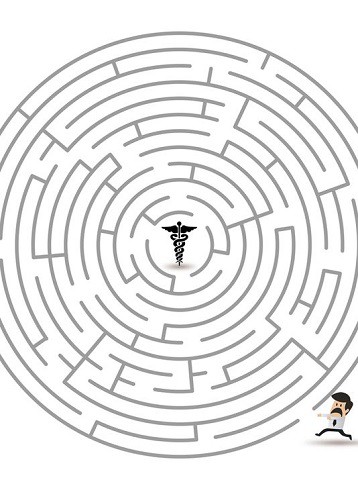Like many Americans, I have been covered by employer-sponsored health plans for the entirety of my professional career. As such, the open enrollment period that has garnered so many headlines over the last few years has conversely been of little concern to me.

Very much so, it turns out. Here’s a synopsis of the time and effort I put into choosing a health plan for 2017.
July: Emailed a friend who’s an independent contractor to ask for advice. He offered shopping suggestions and also forwarded some general price quotes. Forcibly removed jaw from floor after seeing the cost of the plans’ monthly premiums.
October: Read a primer on off-exchange and small-group market plans. Decided that “metal distribution,” in addition to describing the availability of on- vs. off-market ACA-compliant plans, would be a good name for a used record store.
Nov. 1: Logged onto MA Health Connector, the Commonwealth’s health insurance exchange (HIX), to get insurance quote. Discovered that I could not compare more than 3 plans at a time, which seemed counterproductive to the whole “it’s best to shop around” mantra of open enrollment. Also looked at the site’s Provider Directory to see if my PCP was covered, and the names of the plans in the directory did not match the names of the plans on the exchange. Sighed, then logged off.
Nov. 1: MA Health Connector sent a snail mail letter indicating that I qualify for coverage starting Jan. 1, 2017 but can only enroll if I had had a qualifying event – which is just plain wrong. Sighed and ignored letter.
Nov. 4: Read another article about shopping for your own health insurance plan. Didn’t learn anything, unfortunately.
Nov. 4: Called current insurer to inquire about 2017 plans. After 15 minutes on hold, was told to go online even though the website said, in big letters, to call if you are a current member and you want to inquire about plans. Punched in my information, got some specifics about four plans available to me, and printed out a spreadsheet.
Nov 7: Emailed my accountant to ask about the tax deduction for individual health insurance plans. Only thought to do this after a conversation with a second friend with experience buying individual plans – ones much more complicated than mine, it turns out. Received news from my accountant that alleviated the sticker shock for the monthly premiums I faced.
Nov. 8: Went back to MA Health Connector to compare plans available there to plans available from current insurer – three at a time, of course – and started making a digital spreadsheet. Noticed that the Provider Directory was now up to date. Enlisted the help of a third friend who knows how to write formulas in spreadsheets so that I could project 2017 out-of-pocket costs for various health plans, taking into consideration if nothing happens at all, if I need to visit the ER, or if I need to go through physical therapy after hurting myself in a marathon. (Again.)
Nov. 19: Departed for a three-week vacation to New Zealand. This trip had been scheduled months in advance and was unrelated to the stress of researching insurance plans. (Mostly.)
Dec. 8: MA Health Connector sent a snail mail letter correcting the error it had made five weeks before to tell me that yes, in fact, it is open enrollment time, but I only have until Dec. 23 to enroll for coverage starting Jan. 1. Laughed, ignored the letter again, and wondered how much it cost MA Health Connector to print and mail both letters.
Dec. 14 and 15: Tried to purchase a plan, as the jet lag had finally worn off, only to discover that the MA Health Connector site was down. The next day, I saw a strange error when I logged in. I complained on Twitter and, to the MA Health Connector’s credit, received a quick response. (Darn browser cache.) Bought health and dental insurance. Pumped fist.
Dec. 21: Received two email reminders – one from the state, one from the insurer – to pay my bill. Did that, as it sounded like a good idea. Hadn’t paid right away because the site needed four hours to process my application before it could accept payment, and by then I was halfway through my celebratory dinner.

All told, I needed the help of three friends, one accountant, a spreadsheet, and tech support to choose a health plan for 2017. Meanwhile, one phone call to my 2016 insurer and two letters from my state HIX offered little reassurance and no help. All this for a plan I likely will not keep in 2018. But hey, at least the process built character, right?
A microcosm of a much larger problem
As healthcare enters its next and must uncertain phase of reform, the refrain of giving consumers more choice – in how (if at all) they are insured, where they receive care, and how they pay for that care, among other things – will likely ring louder than ever.
For choice to truly work, consumers need clear, concise information about what insurance (as well as care) will cost, along with professional assistance in deciding what is necessary, optional, or frivolous. My open enrollment experience demonstrates that, to date, none of this is readily available to even an informed consumer.
Choice in healthcare is helpful, and long overdue, but the industry’s efforts to empower consumers to make informed choices have been inadequate to the point of irresponsible. Improved price transparency, digital health services for comparison shopping, and better access to less expensive and more convenient care venues all remain the exception to the rule of monolithic care delivered in a fee-for-service system that makes more money when consumers don’t know their choices.
As I wrote in my first blog post for Chilmark Research roughly 18 months ago, healthcare reform has given consumers more sticks than carrots. In the short term, forcing consumers to make healthcare choices that others previously made on their behalf will only bring more sticks. Whether there are carrots on the end will depend on whether consumers have been empowered to make informed choices.




Brian, thank you for documenting your experience but you are vastly understating the problem. I, like you, am a somewhat knowledgeable customer of the MA Health Connector but my experience goes back to the days of RomneyCare. It’s much worse than you claim. The experience got noticeably worse when the ACA kicked in. The billing problems have wasted days, maybe weeks of our life over the years. The plans change every year which means that our insurance companies have changed four times in 5 years. How do we expect any insurance plan to improve under this kind of churn? The prices have gone up as steadily as you describe.
But to your main point about consumer empowerment, in 2012 I wrote a post for WBUR’s Healthcare Savvy titled “Your health data could be worth over $3,000 / year” that pointed out how the MA state all payer claims database (APCD) could be used to inform the choice of plans on the exchange _for each specific beneficiary_. I was partly responsible for putting into the Ch. 224 “RomneyCare” law a provision that would allow patients access to our own information in the APCD so an accountant or a service could price the actual out-of-pocket costs for different plans in arrears. Since then, I’ve had conversations with the director of the state APCD and with the attorney generals of two administrations, Democrat and Republican. They have no interest or intention in enforcing the provision for patient-access to data in the APCD.
I can only conclude that, at least in MA, we have a system that is designed to capture as much of my income to support the local medical economy as possible. Here’s hoping Chilmark pays better than my Texas-based not-profit Patient Privacy Rights where I’m a volunteer.
Adrian, thanks for taking the time to reply, and thanks as well for your hard work. I try not to be cynical about the function of the healthcare system in this country, but my experience, and especially yours, makes that rather difficult.